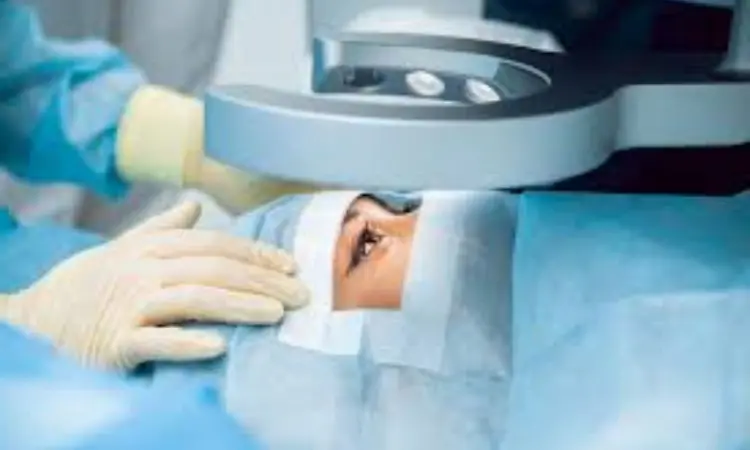- Home
- Medical news & Guidelines
- Anesthesiology
- Cardiology and CTVS
- Critical Care
- Dentistry
- Dermatology
- Diabetes and Endocrinology
- ENT
- Gastroenterology
- Medicine
- Nephrology
- Neurology
- Obstretics-Gynaecology
- Oncology
- Ophthalmology
- Orthopaedics
- Pediatrics-Neonatology
- Psychiatry
- Pulmonology
- Radiology
- Surgery
- Urology
- Laboratory Medicine
- Diet
- Nursing
- Paramedical
- Physiotherapy
- Health news
- Fact Check
- Bone Health Fact Check
- Brain Health Fact Check
- Cancer Related Fact Check
- Child Care Fact Check
- Dental and oral health fact check
- Diabetes and metabolic health fact check
- Diet and Nutrition Fact Check
- Eye and ENT Care Fact Check
- Fitness fact check
- Gut health fact check
- Heart health fact check
- Kidney health fact check
- Medical education fact check
- Men's health fact check
- Respiratory fact check
- Skin and hair care fact check
- Vaccine and Immunization fact check
- Women's health fact check
- AYUSH
- State News
- Andaman and Nicobar Islands
- Andhra Pradesh
- Arunachal Pradesh
- Assam
- Bihar
- Chandigarh
- Chattisgarh
- Dadra and Nagar Haveli
- Daman and Diu
- Delhi
- Goa
- Gujarat
- Haryana
- Himachal Pradesh
- Jammu & Kashmir
- Jharkhand
- Karnataka
- Kerala
- Ladakh
- Lakshadweep
- Madhya Pradesh
- Maharashtra
- Manipur
- Meghalaya
- Mizoram
- Nagaland
- Odisha
- Puducherry
- Punjab
- Rajasthan
- Sikkim
- Tamil Nadu
- Telangana
- Tripura
- Uttar Pradesh
- Uttrakhand
- West Bengal
- Medical Education
- Industry
Longitudinal and transversal handpieces on phaco system produce similar results

Cataract Surgery
Cataract surgery involves breaking up and removing the natural lens with a phacoemulsification (phaco) device, then replacing the natural lens with an artificial lens. Phaco handpieces and settings can be changed to achieve various goals. Although phaco is very safe, the process can put the cornea at risk of irreparable damage. One of the risk factors is the length of time and the energy used during phacoemulsification. Therefore, it is in the best interest of the surgeon to optimize settings for efficient removal of the natural lens. In this study, we compared the efficiency of longitudinal and transversal handpieces. Pig lenses soaked in formalin were used to replicate a human natural lens with a cataract. Efficiency was measured by the time taken to separate the lenses into two pieces using a process called grooving. The findings in this study by Wilkinson et al are important for determining which handpiece is most efficient for grooving.
Cataractous lenses were simulated by exposing porcine lenses to formalin for 2 hours. A total of 120 lenses were analyzed at various power settings on both longitudinal and transversal handpieces. Twenty trials each were performed with power set to 25%, 50%, and 75% on both handpieces. A Whitestar Phaco Handpiece System was used to provide longitudinal power, and a Whitestar Signature Ellipsis Handpiece provided transversal power. Lenses were placed within a plastic chamber and grooved by an investigator blinded to settings. A second investigator recorded times and adjusted settings. The Whitestar Signature Pro phaco system was used for grooving.
There was no significant difference in grooving times between the longitudinal and transverse handpieces at any power setting (P > 0.05). There was a significant decrease in grooving times when comparing the 25% power setting with the 75% power setting for the transversal handpiece (P=0.021).
At each power setting, the longitudinal and transversal handpieces on the Whitestar Signature Pro phaco system produced similar results. For each respective handpiece, there is a trend in decreased grooving times for higher power settings, which demonstrates increased efficiency. The transversal handpiece had a statistically significant decrease in grooving times at increasing power settings. Thus, the transversal handpiece may be more affected by changes in power than the longitudinal handpiece. Grooving efficiency is an important attribute during phaco. The duration of phaco and the amount of dissipated energy during phaco increase the likelihood of damage to the corneal endothelium. More power typically increases efficiency; however, increased power may also increase adverse effects caused by chatter and excess delivered energy. Therefore, the goal of phaco settings should be to find an optimal power setting with sufficient power to minimize duration of phaco without increasing power to the point of excessive chatter that may nullify the benefits of the higher power.
In conclusion, grooving time does not aid in selection between transversal and longitudinal phaco using the Whitestar Signature Pro system. Surgeon preference would appear to be more important in choosing the ultrasound mode used during the grooving step of cataract surgery.
Source: Wilkinson et al; Clinical Ophthalmology 2023:17 191–195
https://doi.org/10.2147/OPTH.S391928
Dr Ishan Kataria has done his MBBS from Medical College Bijapur and MS in Ophthalmology from Dr Vasant Rao Pawar Medical College, Nasik. Post completing MD, he pursuid Anterior Segment Fellowship from Sankara Eye Hospital and worked as a competent phaco and anterior segment consultant surgeon in a trust hospital in Bathinda for 2 years.He is currently pursuing Fellowship in Vitreo-Retina at Dr Sohan Singh Eye hospital Amritsar and is actively involved in various research activities under the guidance of the faculty.
Dr Kamal Kant Kohli-MBBS, DTCD- a chest specialist with more than 30 years of practice and a flair for writing clinical articles, Dr Kamal Kant Kohli joined Medical Dialogues as a Chief Editor of Medical News. Besides writing articles, as an editor, he proofreads and verifies all the medical content published on Medical Dialogues including those coming from journals, studies,medical conferences,guidelines etc. Email: drkohli@medicaldialogues.in. Contact no. 011-43720751


